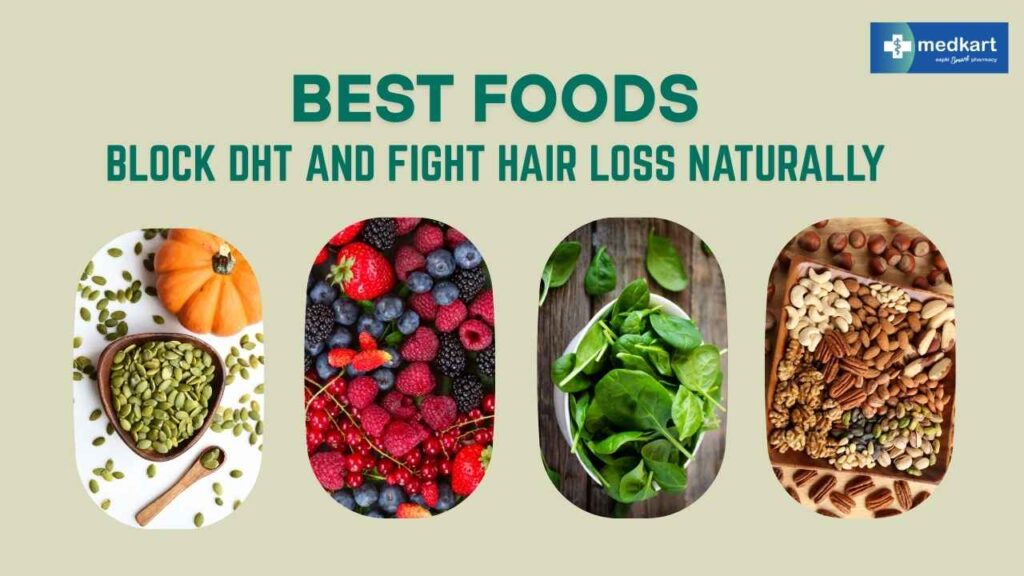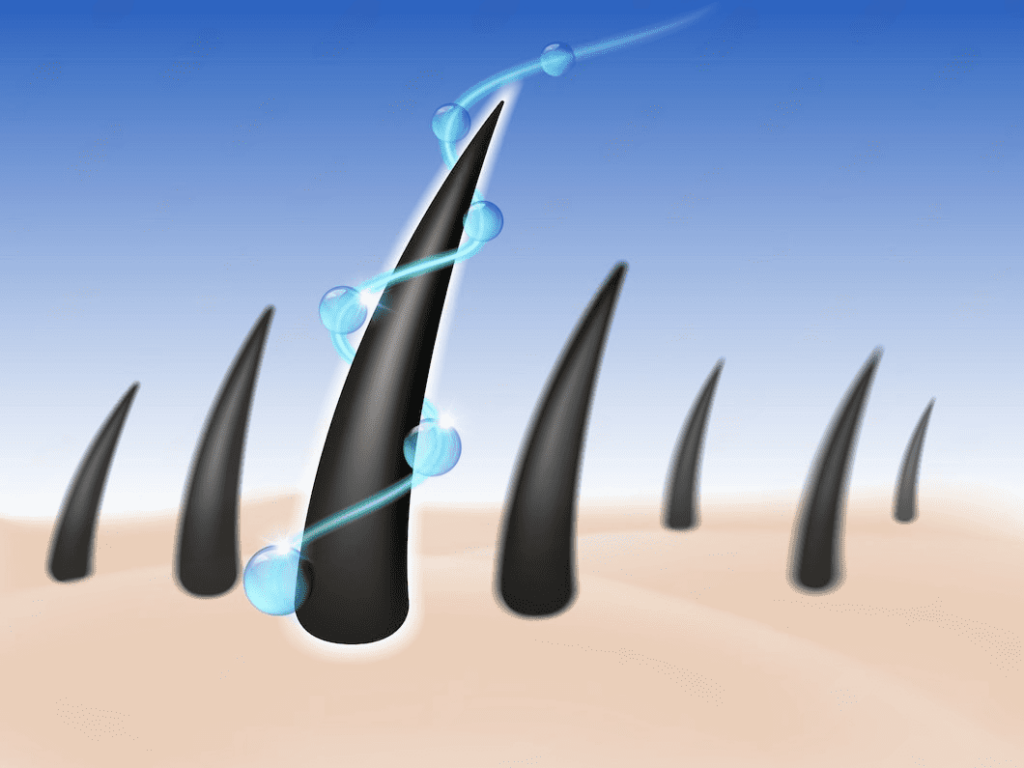Last updated on April 5th, 2025 at 05:48 pm

Hair loss can be distressing, whether it is male or female pattern hair loss. One of the major culprits behind thinning hair is dihydrotestosterone, a hormone derived from testosterone. High levels of DHT can shrink hair follicles, eventually leading to hair loss. Fortunately, incorporating certain foods into your diet can help block DHT naturally and even promote regrowth.
Understanding DHT and Hair Loss
Dihydrotestosterone hair loss is where DHT goes and causes binding to receptors on the scalp. This leads to the reduction of the sizes of follicles, and their intervals become shorter for their growth cycles. It affects males and females, though it shows up differently. In males, it causes a receding hairline and bald spots. Females are presented with thinning hair spread along the scalp, which is popularly known as female pattern hair loss.
So how would one block DHT or the means of regrowing hair naturally? Diet and lifestyle adjustments could make a big difference. Here are foods and strategies that help reduce DHT levels.
Top DHT Blocker Foods
1. Pumpkin Seeds
Pumpkin seeds are high in zinc, a mineral that inhibits the enzyme 5-alpha-reductase, which converts testosterone into DHT. Natural consumption can help block DHT. Snack on a handful of raw pumpkin seeds daily or add them to salads and smoothies.
2. Green Tea
Green tea contains catechins, such as epigallocatechin gallate (EGCG), which inhibit the production of DHT by preventing 5-alpha-reductase. Drinking two to three cups of green tea every day can decrease DHT and prevent hair loss.
3. Spinach
Spinach is a rich source of magnesium, iron, and vitamins that promote hair growth. Magnesium helps in reducing the production of DHT by keeping the hormone in balance. It also enhances overall scalp health with spinach in the diet.
4. Tomatoes
Rich in lycopene, tomatoes are great for DHT control. Lycopene is a very strong antioxidant that blocks 5-alpha-reductase activity. Cooked tomatoes increase lycopene absorption, so it is an excellent food to block DHT.
5. Nuts, especially almonds and walnuts
Nuts are rich in biotin, zinc, and healthy fatty acids, which help nourish hair. Zinc, as stated above, is a natural DHT blocker, and biotin helps strengthen hair strands. Eating a handful of nuts daily will surely enhance hair growth.
6. Flaxseeds
Flaxseeds are rich in lignans and omega-3 fatty acids. These compounds work as DHT blockers. Also, they help minimize inflammation in the scalp, allowing the hair follicles to function properly. Add flaxseeds to your breakfast cereals, yogurt, or smoothies.
7. Berries
Berries contain a lot of antioxidants. They protect against oxidative stress, which contributes to hair loss. Vitamin C helps to boost collagen and strengthens hair follicles, reducing DHT impact indirectly.
How to Reduce DHT Naturally
In addition to diet, there are other measures you can take to regulate DHT levels:
- Healthy Lifestyle: Exercise regularly as it helps regulate hormones and decrease excess testosterone, which in turn reduces DHT.
- Manage Stress: High stress levels can affect hormone levels, thereby indirectly increasing DHT. Meditation and yoga can help manage stress.
- Avoid Foods That Raise DHT: Processed foods, junk food, and red meat are known to increase the production of testosterone and DHT. These should be avoided in the diet to keep hair healthy.

How to Block DHT and Regrow Hair Naturally
The combination of a DHT-blocking diet with natural remedies can prove to be quite effective. Here are some of them:
- Essential Oils: Massage the scalp with rosemary, peppermint, or pumpkin seed oil to block DHT.
- Scalp Exfoliation: Removing dead skin and excess sebum may improve hair follicle health and prevent DHT buildup.
- Herbal Supplements: Saw palmetto is the most famous herbal remedy for DHT hair loss. It inhibits 5-alpha-reductase just like some foods do.
Key Foods That Increase DHT
While some foods naturally help block dihydrotestosterone (DHT), others can inadvertently increase its production, accelerating hair loss. Knowing which foods to limit or avoid is essential if you’re trying to manage hair health.
1. Red Meat
Red meat, especially the fat cuts, has saturated fats and cholesterol. These elements increase the testosterone levels in the body, which further transform into DHT by the enzyme 5-alpha-reductase. Thus, higher consumption of red meat helps increase the levels of DHT and also promotes hair follicle shrinkage.
2. Dairy Products
Hormones produced by cows and also found in dairy products include hormones such as precursors for testosterone that stimulate DHT. Furthermore, higher fat intake within the higher-fatty food sources can facilitate greater activity from the 5-alpha-reductase.
3. Sugary and processed foods
High sugar diets cause spikes in insulin levels, which in turn indirectly raise DHT. High insulin enhances the production of androgens, which contributes to DHT-related hair loss. Processed snacks, sugary drinks, and desserts should be minimized to maintain balanced hormones.
4. Fried and oily foods
Trans fats and unhealthy oils in fried foods can disrupt hormonal balance and elevate testosterone, subsequently increasing DHT levels. These fats may also contribute to scalp inflammation, further damaging hair follicles.
5. Alcohol
Excessive alcohol consumption can disrupt liver function, which plays a role in hormone regulation. This disruption can lead to increased levels of DHT and other androgens in the body.
Limit these foods and instead, include DHT-blocking alternatives such as pumpkin seeds, green tea, and flaxseeds in your diet. Maintaining a well-balanced diet rich in nutrients is the key to protecting your hair from damage caused by DHT.
How to Control DHT Levels for Long-Term Hair Health
Consistency is key when it comes to managing DHT hair loss. Here’s a summary of actionable steps:
- Incorporate DHT blocker foods like pumpkin seeds, green tea, and flaxseeds into your daily diet.
- Steer clear of food items that boost DHT levels, such as red meat and processed snacks.
- Use a healthy diet in combination with natural treatments, such as scalp massages and essential oils.
- Maintain an active lifestyle and minimize stress to ensure proper hormone regulation.
Female Pattern Hair Loss
Female pattern hair loss is also referred to as androgenetic alopecia. It’s the most common form of female hair loss and is different from male pattern baldness as it causes the hair to thicken across the scalp, while in males it leads to bald spots or a receding hairline.
The chief cause of FPHL is hormonal changes with the effects of dihydrotestosterone (DHT). DHT binds to follicles and causes them to shrink, thereby shortening the hair growth cycle leading to finer, weaker hairs. Other associated contributions include genetics, aging, and conditions such as polycystic ovary syndrome.
The advancement of FPHL is progressive. However, there is a possibility for controlling it. For this purpose, DHT blockers are used both medically and naturally such as pumpkin seeds, green tea, and minoxidil. Besides, a proper diet, reduced stress, and proper scalp care can help promote hair health while slowing down hair loss.
Conclusion
Knowing how to block DHT naturally is a game-changer in fighting hair loss. By focusing on DHT blocker foods, avoiding triggers, and adopting a healthy lifestyle, you can control DHT levels and promote hair regrowth. Whether it’s female pattern hair loss or general thinning, these natural methods provide a holistic approach to achieving stronger, healthier hair.
FAQs on Best Foods to Block DHT and Fight Hair Loss Naturally
1. What are the best foods to block DHT and promote hair growth?
Pumpkin seeds, green tea, flaxseeds, and tomatoes are some natural DHT blockers. These foods have nutrients like zinc, lycopene, and omega-3 fatty acids that will prevent the enzyme 5-alpha-reductase from converting testosterone into DHT. Their regular consumption reduces DHT levels and promotes a healthier scalp environment.
2. How to reduce DHT through diet alone?
For the reduction of DHT through diet, one needs to focus on zinc, antioxidant, and omega-3 food items, including nuts, berries, and green vegetables, while avoiding the intake of red meat and dairy, which increase the DHT production. It is essential for hormonal balance with a balanced diet for managing DHT levels.
3. Can green tea reduce DHT levels?
Yes, green tea is a very effective natural remedy to reduce DHT levels. It contains catechins like EGCG that inhibit the production of 5-alpha-reductase. Drinking two to three cups of green tea daily can significantly reduce DHT and support hair health.
4. How to lower DHT levels naturally without medication?
You can naturally reduce DHT levels by consuming DHT-blocking foods, reducing stress, and maintaining a healthy lifestyle. Scalp massages with essential oils like rosemary and regular exercise can also help balance hormones. These natural methods are effective and have minimal side effects.
